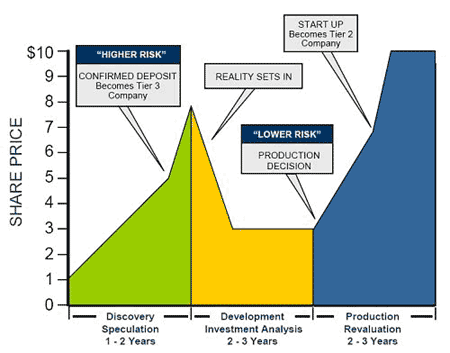A chance to buy into China's gold mining boom dirt cheap
Gold and silver are still strong, and it looks like junior miners have decoupled from the falling stock markets. That means now might be a good time to pick up a bargain.
This feature is just part of our FREE daily email. Sign up for Money Morning here.
Why junior miners might just be about to take off
I am starting to feel very bullish about junior mining companies, more bullish than I've felt for a long time. Several factors suggest to me we could be set for a very nice run here.
MoneyWeek
Subscribe to MoneyWeek today and get your first six magazine issues absolutely FREE

Sign up to Money Morning
Don't miss the latest investment and personal finances news, market analysis, plus money-saving tips with our free twice-daily newsletter
Don't miss the latest investment and personal finances news, market analysis, plus money-saving tips with our free twice-daily newsletter
For starters, having called the Federal Reserve's inflation-fighting bluff last week, gold and silver are looking extremely strong. So what?' you say. Gold and silver were strong last year and the juniors hardly budged'.
Well, that's just it. In the great stock market falls of August last year, and January and March of this year, the juniors sold off dramatically and painfully. But last week, as the Dow Jones plummeted towards the gates of hell - with the keeper smiling and jangling his keys - the juniors lost all sympathy with the general indices and moved up.
In other words, it looks as though they might have decoupled. At long last.
Chartists will note that the moving averages of many junior miners are lined up beautifully. Value-driven investors will note the bargain prices, which is why we are starting to see a number of significant moves from seniors into the junior sector, the most recent being a $50m investment from Agnico into Gold Eagle mines.
And news-driven traders will note the huge campaigns, one by Jim Puplava, host of the internet's leading financial podcast, the other by Jim Sinclair, a veteran gold trader with a huge following, against the practice of naked short-selling which they say is rife among junior miners. (Naked short selling, or naked shorting, is selling a stock short without first borrowing the shares or ensuring that the shares can be borrowed).
After hearing five minutes of Puplava or just skim-reading Sinclair, any sensibly-minded short-seller who values his freedom will be covering his shorts quicker than you can say, Securities and Exchange Commission'.
But the state of the capital markets is such that I wouldn't be rushing to buy any explorers just yet. Mineral exploration burns cash almost as rapidly as your local council and many are having problems finding funding.
The life cycle of a miner
There is an idealised cycle in mining companies that is beautifully described by Frank Holmes in this now-famous chart.

Then reality sets in. "Actually, this thing is going to take four years to bring into production, even with all our modern mining methods. We've got to build a road, a mill, shafts, tunnels. How are we going to get power here? What about water? And permits. We're going to need permits. Lots of permits. And people. We're going to need lots of them too. Good ones."
Finally, an accountant speaks up: "It's going to cost X million pounds".
"X million pounds?"
"I'm afraid so. Possibly even Y million. And it's going to take a minimum of three years."
"Oh, no. How are going to keep impatient investors interested all that time?"
The answer is: "You're not."
Without exciting newsflow or cashflow, investors quickly lose interest and the stock sells off. But after several years working hard on the project, developing the asset, bringing in roads and power, building the infrastructure, getting the right people in, an analyst perks up. "Hey, you remember that project. It's not looking so bad after all. They'll be in production by next year." "Really?" Gradually, investor interest creeps back and the stock starts to perk up.
And here's a company that's at that stage
One company that is at the beginning of that third phase in the cycle is Leyshon Resources (AIM:LRL). It's a company I've tipped before as a buy below 25p. I'm a shareholder and I'm a fan.
Leyshon is developing a gold asset in China. I don't need to sell you the China gold story. The country has become the world's largest gold producer and, after India, the second largest gold consumer. (For more on this, see: Why you should buy this Chinese gold miner).
Leyshon has a market cap of around £50m. Its main asset is in Northern China - Leyshon owns 70% and the Chinese Qiqiha'er Geological Brigade owns 30%. They've so far proven up reserves of 1.2 million ounces of gold, 4.5 million ounces of silver and 120,000 tonnes of zinc. These reserves are likely to increase as they explore and develop other ore bodies nearby. They are combining Aussie mining design and expertise with low Chinese operating costs - a production cost of $250 per ounce is predicted.
Three bits of news have come out lately, which tell a big story. Firstly, on June 19th, they announced that construction of the main 8.6 kilometre access road had begun and will take 90 days. Road construction is not something you undertake without good reason.
Then the following week it was announced that, after two years of detailed work, all the necessary environmental approvals and permits are in place. The next stage as development accelerates will be the remaining permitting and commencement of construction of the power lines. But the inference is clear: this is going to be a mine.
But it's not just going to be a mine. On Monday came the announcement that Leyshon is looking to secure a listing in Hong Kong. This is a process that might take some time, but on the Hong Kong exchange there are currently only five listed gold miners and they trade on amazing ratings. As this story develops, you can expect the Chinese to become more and more involved in terms of investment and growth, just as they have with Jinshan.
Leyshon boss Paul Atherley, is an extremely level-headed and capable leader, who understands the need to keep promoting a story even in the barren second phase of the mining life cycle. He's also savvy enough to deal with everyone from the most stubborn Chinese official to the trickiest employee to the smallest, but noisiest shareholder. The management team owns about 15% of the company, so is well incentivised to act in the best interests of shareholders. That's just as well, because more funds are going to be needed as this moves this into production and shareholders won't want to see too much dilution. I believe the strategy is to raise a portion of the money soon - Atherley will be in London this month, presumably to talk to fund managers - and the rest at a higher price early next year, ideally after a Hong Kong listing and a higher rating is achieved.
The stock closed at 22p yesterday. If you believe in gold, in China and in the above life-cycle of mining companies, this represents a very low-risk entry price into a company which I believe could soon grow to be a major player in the Asian gold mining industry.
Turning to the wider markets
Enjoying this article? Why not sign up to receive Money Morning FREE every weekday? Just click here: FREE daily Money Morning email.
The FTSE 100 ended Tuesday's session down 146 points at 5,479, as grim news on house prices and manufacturing battered investor confidence. Banks were among the main fallers
Over in Europe, the Paris CAC 40 fell 93 points to 4,341. Meanwhile, the German Xetra Dax was down 102 points at 6,315.
Over in the US, the Dow Jones Industrial Average rallied a little, gaining 32 points to close at 11,382, as General Motors' June sales were not as bad as expected. The wider S&P 500 gained 4 points to 1,284, while the tech-heavy Nasdaq Composite rose 11 points to 2,304.
Overnight, in Japan, the Nikkei 225 fell for the tenth session in a row, as slowing vehicle sales in India hurt car manufacturer Suzuki and raised fears over demand in emerging economies. The index lost 176 points to 13,286.
Brent spot was trading this morning at $141.28, and in New York, crude oil was at $142. Spot gold was trading at $941 an ounce. Silver was trading at $18.14 and Platinum was at $2,078.
In the forex markets this morning, sterling was trading against the US dollar at 1.9913 and against the euro at 1.2578. The dollar was trading at 0.6319 against the euro and 106.08 against the Japanese yen.
And this morning, housebuilder Taylor Wimpey has seen its shares drop by more than half in early trading on news that it has not yet been able to raise fresh money from investors. The group plans to cut 900 jobs and will not pay a first-half dividend.
Get the latest financial news, insights and expert analysis from our award-winning MoneyWeek team, to help you understand what really matters when it comes to your finances.
MoneyWeek is written by a team of experienced and award-winning journalists, plus expert columnists. As well as daily digital news and features, MoneyWeek also publishes a weekly magazine, covering investing and personal finance. From share tips, pensions, gold to practical investment tips - we provide a round-up to help you make money and keep it.
-
 Top 10 locations for buyers and renters revealed
Top 10 locations for buyers and renters revealedLondon is crowned as the most popular location for renters and buyers, despite rising costs. But where else are house hunters heading to?
-
 Making financial gifts to loved ones? Write it down or risk giving an IHT bill too
Making financial gifts to loved ones? Write it down or risk giving an IHT bill tooGiving gifts can be a way to pass on wealth and reduce the inheritance tax bill on your estate but do it wrong and you could leave family and friends more than they bargained for.

